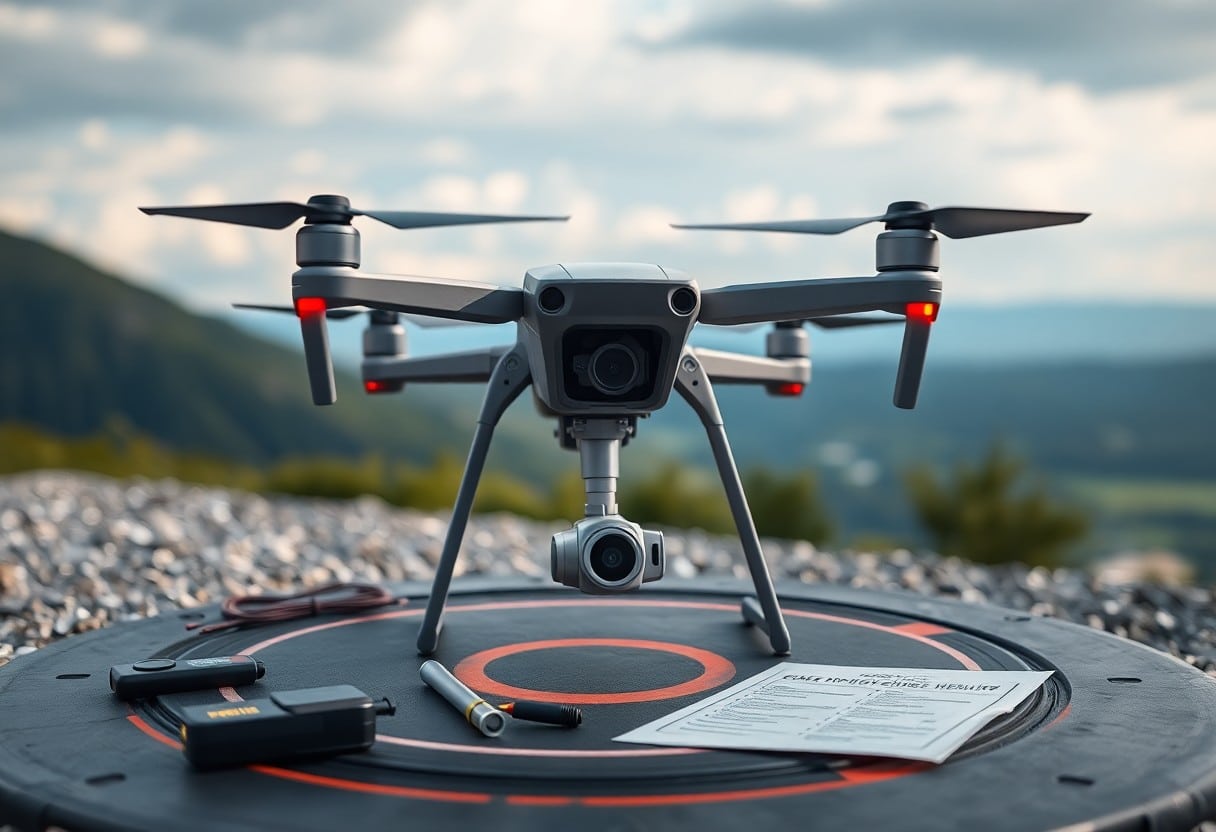Ultimate Pre-Flight Checklist - 9 Steps to Effective Drone Operations
Before flying a drone, you need to understand and follow aComprehensive and effectiveThe checklist will be used to ensure thatsuretyrespond in singingefficientlyThe operation of the This post will provide you withNine Key StepsThis will allow you to perform a flight check on your drone before each takeoff.Thorough ExaminationThis will help you avoid potential risks and enhance your overall flying experience. By following these steps, you will be able to fly your drone with confidence, making every flight fun and fulfilling.

Key Points:
- Plan the flight path:Determine a clear flight path before takeoff to avoid accidents.
- Check weather conditions:Ensure that the weather is suitable for drone operation and avoid strong winds and rain.
- Battery check:Ensure that the drone's batteries are full and check the status of the spare batteries.
- Equipment check:Carefully check that the drone and its accessories are in good condition and are not damaged or malfunctioning.
- Flight regulations:Know and follow local flying regulations to avoid breaking the law.
- Prior testing:System tests are conducted before the official flight to ensure that everything is functioning properly.
- Keep a safe distance:Keep away from people and other objects during flight to ensure safe operation.
Know your local laws and regulations
Before operating a drone, it is important that you are aware of local regulations to ensure that your flight is in compliance. Complying with these regulations not only protects you, but also protects others and property, and reduces potential legal risks. Therefore, before taking off, you should ensure that you are familiar with and comply with the relevant local rules and regulations.
FAA Guiding Principles
Under FAA guidelines, you are required to follow the basic rules of drone operation, including altitude restrictions, visual flight, and avoidance of controlled areas. These rules are designed to ensure public safety and you must take them seriously or risk legal liability or having your drone confiscated.
Local airspace restrictions
When flying a drone, understandLocal airspace restrictionsIt's important. Many areas have special flight restrictions, such as no-fly zones or areas that require a permit. You should always check local airspace information and follow the regulations to avoid improper operation of your drone in these areas.
Local airspace restrictions may coverAround the Airportrange of several miles, as well as the specificCity or State ParksThe purpose of these restrictions is to protect the safety of persons and property and to prevent drone interference with air traffic. The purpose of these restrictions is to protect the safety of people and property and to prevent the drone from interfering with air traffic. Therefore, you should use a reliable tool, such as a map application or a drone-specific application, to verify that the area in which you are flying is restricted. If you cause an accident by disregarding these restrictions, the consequences are not only harm to others, but may also expose you to legal liability.
Pre-flight Plan
You need to plan carefully before performing drone operations. This includes checkingUnleash Your Potential - 7 Steps to Complete Proficiency with 3D Modeling SoftwareTo make sure you have all the necessary equipment and know your flight path and objectives, you need a detailed plan. Detailed planning not only improves safety, but also enhances the overall flying experience.
Flight Area Assessment
Assessing the flight area is an important step for every drone operator. You should investigate the site for any potential obstacles, such as trees, tall buildings, or other structures, to help ensure that your drone is not exposed to unexpected hazards during flight.
Weather conditions
Before you fly, learn about the currentWeather conditionsThat's the key. Strong winds, rain or poor visibility can all pose a threat to flight safety. You need to use a reliable weather forecasting tool to determine if it's appropriate to fly, and to take into accountLow TemperaturePossible effects on drone battery performance.
Special attention should be paid toStrong windThis may result in loss of control of the drone or unstable surveillance images. In addition, rainfall or even brief thunderstorms can also reduce the stability of your drone's operation.Avoid flyingThe weather is not as bad as it used to be. Finally, make sure to keep track of weather changes, as conditions can change quickly.
Equipment Inspection
An equipment check is a critical step in operating your drone before each takeoff. Ensuring that your drone is operating in optimal condition reduces the risk of accidents. You can refer toWhat are the basic drone controls every beginner should know?to get helpful tips.
Drone Status Check
Before flying, you should carefully check the overall condition of the drone. Check all parts to make sure they are not damaged, not loose, and are functioning properly. Pay particular attention to any cracks or wear on the propellers, as any small problem can lead to unexpected results.
Battery and payload verification
Before takeoff, it is critical to verify the battery charge and payload weight. Ensure that the batteries are fully charged and checked for any signs of damage or expansion, and that the payload (e.g., cameras or other accessories) should be within the design load range of the drone to avoidDanger from overweightThe
When checking the battery, pay special attention to its power indication and charging status. UseFully charged batterywill ensure that you have enough power while flying and prevent sudden loss of power while in the air. In addition, make sure the payload does not exceed the set limit of the drone, which will prevent theControl difficulties and potential accidentsThe following are some of the most common problems that can occur. Always follow the manufacturer's guidelines to ensure safe and efficient operation.

Software and Firmware Updates
Before conducting drone operations, always ensure that theYour Software and FirmwareAll are the latest versions. This not only helps to improve the performance of the drone, but also enhances its safety. Regularly checking for updates reduces the risk of failure and ensures a smooth flying experience.
Application and System Updates
Before flying, please checkYour Application and SystemAvailability of updates. These updates usually contain important functional improvements and bug fixes that enhance operational stability and security.
Calibration Program
proceedCalibration procedureThis is a critical step in ensuring the proper operation of your drone. Before each flight, follow the manufacturer's instructions for automatic or manual calibration, especially after changing locations or experiencing extreme weather.
existCalibration procedureYou must ensure that the drone's sensors and navigation systems are accurate. This includesMagnetic Field Calibrationrespond in singingAltimeter CalibrationIn addition, it is often necessary to position the drone at different orientations and angles to ensure that it is able to read the environmental data correctly. Neglecting to calibrate the drone may result in unstable flight, and may even cause the drone toDangerousIt is important to check carefully before flying.
Safety Specifications
When conducting drone operations, followSafety SpecificationsIt's important. This not only protects you, but also protects others and their property. Make sure you know your local laws and regulations and check all the features of your drone before flying. Remember, safety always comes first.
Contingency Planning
No matter how careful you are, accidents can happen at any time, so it's important to have a strongContingency PlanIt is essential. This includes the identification of potential risks and the organization of countermeasures to ensure that you can quickly take the right steps in the event of a crisis.
Pre-flight Risk Assessment
proceedPre-flight Risk AssessmentHelps you identify and assess potential hazards before each takeoff. Checking the flight environment, wind speed, visibility, and evaluating surrounding obstacles are all critical factors in your assessment of flight safety.
existPre-flight Risk AssessmentYou need to carefully consider various factors to ensure that your drone flight plan does not cause damage to people or property. Check that weather conditions are suitable for flying, especially in high winds or inclement weather. Also, be aware of possible obstacles in your surroundings, including buildings and trees. Continuing to conduct a thorough risk assessment for each future flight will help to improve the safety and effectiveness of your operations.

Communication and team coordination
In drone operations.Effective CommunicationCoordination with the team is essential. Make sure everyone understands their roles and responsibilities and that there is adequate communication before the flight. You can refer toDrone Permit Application - 9 Steps to Secure Legal Flight in the UKLearn about the experiences of others to help you improve your productivity.
Creating a Role
Before you fly, you need to clarify the roles of each team member. Whether it's maneuvering the drone, coordinating communications, or conducting a risk assessment, a clear division of roles will increase overall productivity and safety.
Signal and Communication Equipment
Choose the right oneSignal and Communication EquipmentIt is vital to ensure the safety of drone operations. The choice of a reliable radio or walkie-talkie can convey vital information in real time during the flight, ensuring that all parties react and adjust quickly.
utilizationHigh quality communication equipmentNot only will you increase the efficiency of your team's collaboration, but you'll also minimize potential risks during operations. Ensure that your chosen equipment has clear sound quality and a stable connection so that you can respond quickly in emergency situations. Additionally, establishing clear signaling protocols further ensures that your team communicates effectively in all environments, avoiding misunderstandings and mistakes and ensuring that everyone is on the same page.High Risk EnvironmentStay Safe in the Workplace. Make it a habit to regularly inspect and maintain this equipment to minimize unforeseen conditions during operation.
Ultimate Pre-Flight Checklist - 9 Steps to Effective Drone Operation
Before operating your drone, following this 9-step pre-flight checklist will ensure your safety and the success of your flight. Each step is critical to help you identify potential problems and ensure proper operation of your equipment. You should regularly check your equipment, review weather conditions, and check all necessary permits. This not only protects your investment, but also ensures a smooth and efficient operating experience. By following these steps, you'll be able to fly with confidence every time.
Frequently Asked Questions
Q: What is the Ultimate Pre-flight Checklist?
A: The Ultimate Pre-Flight Checklist is a nine-step checklist designed to help drone operators prepare and check their equipment prior to flight to ensure a safe and efficient flight.
Q: What are the nine steps?
A: The nine-step process includes: checking weather conditions, checking drone hardware, checking battery status, checking controller connections, checking GPS signals, testing takeoff and landing systems, checking legal regulations for the area in which you are flying, and notifying other aircraft.
Q: Why is confirmation of weather conditions so important?
A: Recognizing weather conditions can help the operator avoid unfavorable flying conditions such as strong winds, heavy rain, or lightning, which may affect the stability and operational safety of the drone.
Q: What should be included in a drone hardware inspection?
A: A drone hardware check should include looking for intact propellers, proper gravity sensors, and the overall structure of the drone for damage or wear.
Q: Why is a battery condition check so important?
A: Checking the battery condition is the key to ensure the continued stable operation of the drone. Insufficient power can cause flight interruption or failure to land safely, resulting in equipment damage or hazardous conditions.
Q: What are the legal requirements I need to check before I fly?
A: Operators need to check local drone flight regulations, including flight altitude restrictions, no-fly zones, whether a permit is required, and other relevant laws to avoid legal risks.
Q: Is there anything else I should be aware of after the above examination?
A: Yes, after performing the above checks, the operator should maintain communication with other aircraft to ensure that there is no interference with other flying activities and remain focused during the flight to quickly respond to any unexpected situations.




